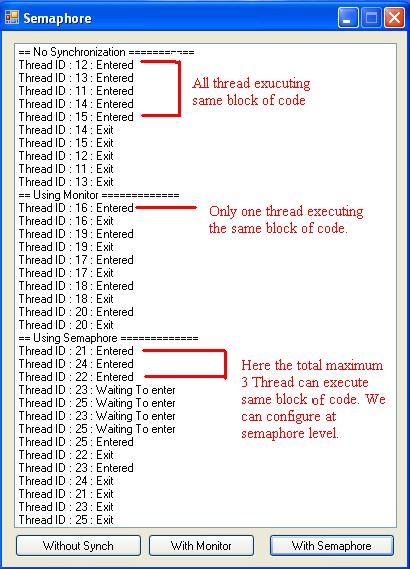
Introduction
Semaphore is a synchronization technique where we can control number of threads to access a resource. In lock/Mutex, only one thread can access resources at a time. But Semaphore allows multiple threads to access the same resource at a time. We can limit the number of threads that can access the same resources. In this article, I have shown three different ways to access resources.
- No-1. No Synchronization
- No-2. Synchronization with Monitor
- No-3. Synchronization with Semaphore
Using the Code
No Synchronization
With no synchronization, all threads run simultaneously and execute the same piece of code simultaneously. There is no restriction on how many threads can access it. Following is the code:
private void btnNoSync_Click(object sender, EventArgs e)
{
listBox1.Items.Add("== No Synchronization ===========");
int TotalThread = 5;
Thread[] Threads = new Thread[TotalThread];
for (int i = 0; i < TotalThread; i++)
{
Threads[i] = new Thread(new ThreadStart(AccessCode));
Threads[i].IsBackground = true;
Threads[i].Start();
}
}
public void AccessCode()
{
listBox1.BeginInvoke(new ParameterizedThreadStart(UpdateUI), new object[]
{"Thread ID : " + Thread.CurrentThread.ManagedThreadId.ToString() + ": Entered" }
);
Thread.Sleep(500);
listBox1.BeginInvoke(new ParameterizedThreadStart(UpdateUI), new object[]
{ "Thread ID : " + Thread.CurrentThread.ManagedThreadId.ToString() + " : Exit" }
);
}
public void UpdateUI(object objOutput)
{
listBox1.Items.Add(objOutput.ToString());
}
Synchronization with Monitor
Synchronization with monitor class, only one thread can access the same resource at a time. Thread is run simultaneously but it can access the block of code one at a time. There is a restriction on thread so that only a single thread can access a particular code block.
private void buttonMonitor_Click(object sender, EventArgs e)
{
listBox1.Items.Add("== Using Monitor =============");
int TotalThread = 5;
Thread[] Threads = new Thread[TotalThread];
for (int i = 0; i < TotalThread; i++)
{
Threads[i] = new Thread(new ThreadStart(AccessCodeWithMonitor));
Threads[i].IsBackground = true;
Threads[i].Start();
}
}
private void AccessCodeWithMonitor()
{
Monitor.Enter(this);
try
{
listBox1.BeginInvoke(new ParameterizedThreadStart(UpdateUI), new object[]
{ "Thread ID : " +
Thread.CurrentThread.ManagedThreadId.ToString() + " : Entered" });
Thread.Sleep(500);
listBox1.BeginInvoke(new ParameterizedThreadStart(UpdateUI), new object[]
{ "Thread ID : " +
Thread.CurrentThread.ManagedThreadId.ToString() + " : Exit" });
}
finally
{
Monitor.Exit(this);
}
}
private void UpdateUI(object objOutput)
{
listBox1.Items.Add(objOutput.ToString());
}
Synchronization with Semaphore
In synchronization with semaphore class, we can allow more than one thread to access the same block of code. Actually, we can specify how many threads can access the same block of code at the same time.
private void btnSemaphore_Click(object sender, EventArgs e)
{
listBox1.Items.Add("== Using Semaphore =============");
int TotalThread = 5;
int SemaphoreCount = 3;
Thread[] Threads = new Thread[TotalThread];
Semaphore Sema = new Semaphore(SemaphoreCount, SemaphoreCount);
for (int i = 0; i < TotalThread; i++)
{
Threads[i] = new Thread(new ParameterizedThreadStart
(AccessCodewithSemaphore));
Threads[i].IsBackground = true;
Threads[i].Start(Sema);
}
}
public void AccessCodewithSemaphore(object objSemaphore)
{
bool IsComplete = false;
Semaphore l_SemaPhore = (Semaphore)objSemaphore;
while (!IsComplete)
{
if (l_SemaPhore.WaitOne(200, false))
{
try
{
listBox1.BeginInvoke(new ParameterizedThreadStart(UpdateUI),
new object[]
{"Thread ID : " +
Thread.CurrentThread.ManagedThreadId.ToString() + " : Entered" });
Thread.Sleep(500);
}
finally
{
l_SemaPhore.Release();
listBox1.BeginInvoke(new ParameterizedThreadStart(UpdateUI),
new object[]
{ "Thread ID : " +
Thread.CurrentThread.ManagedThreadId.ToString() + " : Exit" });
IsComplete = true;
}
}
else
{
listBox1.BeginInvoke(new ParameterizedThreadStart(UpdateUI),
new object[]
{"Thread ID :"+Thread.CurrentThread.ManagedThreadId.ToString() +
": Waiting To enter"});
}
}
}
public void UpdateUI(object objOutput)
{
listBox1.Items.Add(objOutput.ToString());
}
Testing the Code
Semaphore can be tested easily. Run the application and press all buttons one by one and see the effect of semaphore which controls the total number of threads that can execute some block of code simultaneously. Semaphore is a resource based synchronization technique and its system wide synchronization resource.
History
- 19th November, 2011: Initial post
